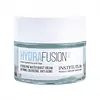What's inside
What's inside
 Key Ingredients
Key Ingredients

 Benefits
Benefits

 Concerns
Concerns

 Ingredients Side-by-side
Ingredients Side-by-side

Water
Skin ConditioningGlycerin
HumectantSqualane
EmollientPrunus Armeniaca Kernel Oil
MaskingButylene Glycol
HumectantUndecane
EmollientSodium Acrylates Copolymer
Tocopheryl Acetate
AntioxidantPanthenol
Skin ConditioningPhenoxyethanol
PreservativeTridecane
PerfumingLecithin
EmollientHydrolyzed Jojoba Esters
Skin ConditioningDisodium Adenosine Triphosphate
Skin ConditioningParfum
MaskingEthylhexylglycerin
Skin ConditioningDisodium EDTA
Sclerotium Gum
Emulsion StabilisingPentylene Glycol
Skin ConditioningAlcohol
AntimicrobialCaprylic/Capric Triglyceride
MaskingAlgin
MaskingCarica Papaya Fruit Extract
Skin ConditioningSodium Hydroxide
BufferingSodium Acetylated Hyaluronate
HumectantSodium Hyaluronate
HumectantBenzyl Alcohol
PerfumingLinalool
PerfumingSodium Hyaluronate Crosspolymer
HumectantPantolactone
HumectantBenzyl Salicylate
PerfumingAscorbyl Palmitate
AntioxidantHydrolyzed Sodium Hyaluronate
Skin ConditioningTetradecyl Aminobutyroylvalylaminobutyric Urea Trifluoroacetate
Skin ConditioningAlpha-Isomethyl Ionone
PerfumingCitric Acid
BufferingLimonene
PerfumingCitronellol
PerfumingMagnesium Chloride
Ascorbic Acid
AntioxidantTocopherol
AntioxidantHelianthus Annuus Seed Oil
EmollientCI 42090
Cosmetic ColorantCI 60730
Cosmetic ColorantWater, Glycerin, Squalane, Prunus Armeniaca Kernel Oil, Butylene Glycol, Undecane, Sodium Acrylates Copolymer, Tocopheryl Acetate, Panthenol, Phenoxyethanol, Tridecane, Lecithin, Hydrolyzed Jojoba Esters, Disodium Adenosine Triphosphate, Parfum, Ethylhexylglycerin, Disodium EDTA, Sclerotium Gum, Pentylene Glycol, Alcohol, Caprylic/Capric Triglyceride, Algin, Carica Papaya Fruit Extract, Sodium Hydroxide, Sodium Acetylated Hyaluronate, Sodium Hyaluronate, Benzyl Alcohol, Linalool, Sodium Hyaluronate Crosspolymer, Pantolactone, Benzyl Salicylate, Ascorbyl Palmitate, Hydrolyzed Sodium Hyaluronate, Tetradecyl Aminobutyroylvalylaminobutyric Urea Trifluoroacetate, Alpha-Isomethyl Ionone, Citric Acid, Limonene, Citronellol, Magnesium Chloride, Ascorbic Acid, Tocopherol, Helianthus Annuus Seed Oil, CI 42090, CI 60730
Water
Skin ConditioningGlycerin
HumectantPropanediol
SolventDimethicone
EmollientIsononyl Isononanoate
EmollientHydroxyethylpiperazine Ethane Sulfonic Acid
BufferingPhenoxyethanol
PreservativeCarbomer
Emulsion StabilisingButylene Glycol
HumectantChlorphenesin
AntimicrobialCaprylyl Glycol
EmollientDimethiconol
EmollientSodium Hydroxide
BufferingXanthan Gum
EmulsifyingPentylene Glycol
Skin ConditioningTetrasodium EDTA
Tocopheryl Acetate
AntioxidantMenthoxypropanediol
MaskingPseudoalteromonas Ferment Extract
HumectantBiosaccharide Gum-1
HumectantSarcosine
Skin ConditioningSalicylic Acid
MaskingWater, Glycerin, Propanediol, Dimethicone, Isononyl Isononanoate, Hydroxyethylpiperazine Ethane Sulfonic Acid, Phenoxyethanol, Carbomer, Butylene Glycol, Chlorphenesin, Caprylyl Glycol, Dimethiconol, Sodium Hydroxide, Xanthan Gum, Pentylene Glycol, Tetrasodium EDTA, Tocopheryl Acetate, Menthoxypropanediol, Pseudoalteromonas Ferment Extract, Biosaccharide Gum-1, Sarcosine, Salicylic Acid
 Reviews
Reviews

Ingredients Explained
These ingredients are found in both products.
Ingredients higher up in an ingredient list are typically present in a larger amount.
Butylene Glycol (or BG) is used within cosmetic products for a few different reasons:
Overall, Butylene Glycol is a safe and well-rounded ingredient that works well with other ingredients.
Though this ingredient works well with most skin types, some people with sensitive skin may experience a reaction such as allergic rashes, closed comedones, or itchiness.
Learn more about Butylene GlycolGlycerin is already naturally found in your skin. It helps moisturize and protect your skin.
A study from 2016 found glycerin to be more effective as a humectant than AHAs and hyaluronic acid.
As a humectant, it helps the skin stay hydrated by pulling moisture to your skin. The low molecular weight of glycerin allows it to pull moisture into the deeper layers of your skin.
Hydrated skin improves your skin barrier; Your skin barrier helps protect against irritants and bacteria.
Glycerin has also been found to have antimicrobial and antiviral properties. Due to these properties, glycerin is often used in wound and burn treatments.
In cosmetics, glycerin is usually derived from plants such as soybean or palm. However, it can also be sourced from animals, such as tallow or animal fat.
This ingredient is organic, colorless, odorless, and non-toxic.
Glycerin is the name for this ingredient in American English. British English uses Glycerol/Glycerine.
Learn more about GlycerinPentylene glycol is typically used within a product to thicken it. It also adds a smooth, soft, and moisturizing feel to the product. It is naturally found in plants such as sugar beets.
The hydrophilic trait of Pentylene Glycol makes it a humectant. As a humectant, Pentylene Glycol helps draw moisture from the air to your skin. This can help keep your skin hydrated.
This property also makes Pentylene Glycol a great texture enhancer. It can also help thicken or stabilize a product.
Pentylene Glycol also acts as a mild preservative and helps to keep a product microbe-free.
Some people may experience mild eye and skin irritation from Pentylene Glycol. We always recommend speaking with a professional about using this ingredient in your routine.
Pentylene Glycol has a low molecular weight and is part of the 1,2-glycol family.
Learn more about Pentylene GlycolPhenoxyethanol is a preservative that has germicide, antimicrobial, and aromatic properties. Studies show that phenoxyethanol can prevent microbial growth. By itself, it has a scent that is similar to that of a rose.
It's often used in formulations along with Caprylyl Glycol to preserve the shelf life of products.
Sodium Hydroxide is also known as lye or caustic soda. It is used to adjust the pH of products; many ingredients require a specific pH to be effective.
In small amounts, sodium hydroxide is considered safe to use. However, large amounts may cause chemical burns due to its high alkaline.
Your skin has a natural pH and acid mantle. This acid mantle helps prevent harmful bacteria from breaking through. The acid mantle also helps keep your skin hydrated.
"Alkaline" refers to a high pH level. A low pH level would be considered acidic.
Learn more about Sodium HydroxideTocopheryl Acetate is AKA Vitamin E. It is an antioxidant and protects your skin from free radicals. Free radicals damage the skin by breaking down collagen.
One study found using Tocopheryl Acetate with Vitamin C decreased the number of sunburned cells.
Tocopheryl Acetate is commonly found in both skincare and dietary supplements.
Learn more about Tocopheryl AcetateWater. It's the most common cosmetic ingredient of all. You'll usually see it at the top of ingredient lists, meaning that it makes up the largest part of the product.
So why is it so popular? Water most often acts as a solvent - this means that it helps dissolve other ingredients into the formulation.
You'll also recognize water as that liquid we all need to stay alive. If you see this, drink a glass of water. Stay hydrated!
Learn more about Water